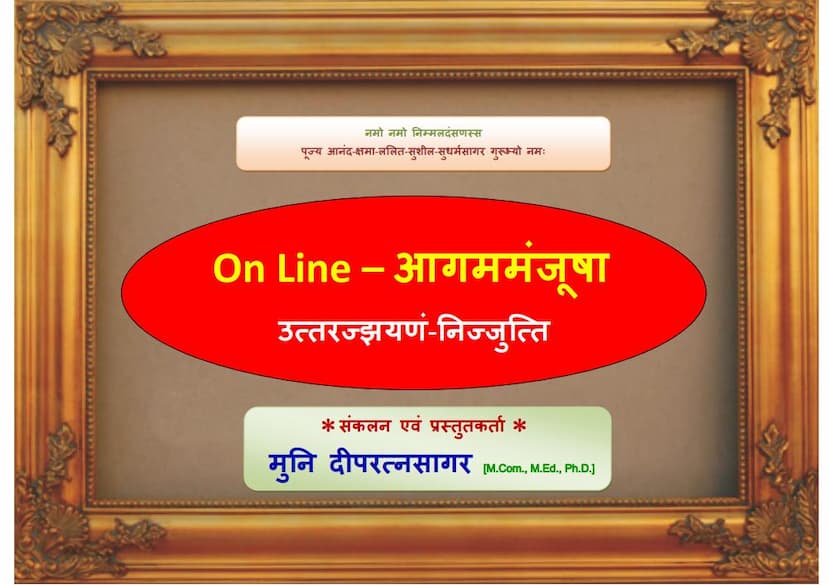Aagam Manjusha N 43 Uttarjjhayan Nijjutti
Added to library: September 1, 2025

Summary
Here's a comprehensive summary of the provided Jain text, "Aagam Manjusha N 43 Uttarjjhayan Nijjutti," based on the scanned pages:
Book Title: Aagam Manjusha N 43 Uttarjjhayan Nijjutti Author(s): Anandsagarsuri, Sagaranandsuri (as editors/compilers of the earlier edition) Publisher: Deepratnasagar Compiler/Presenter of Online Edition: Muni Deepratnasagar
Core Subject Matter:
This text is the Nijjutti (Nyaya), or commentary/explanation, on the Uttaradhyayana Sutra, a significant scripture in Jainism. The Uttaradhyayana Sutra is considered one of the most important and comprehensive texts within the Jain Agamas, covering various aspects of Jain philosophy, ethics, and spiritual practice. The Nijjutti provides a detailed explanation and elaboration of the original sutras.
Key Themes and Content:
The text is structured around the 36 chapters (adhyayana) of the Uttaradhyayana Sutra. The Nijjutti systematically explains each chapter, providing insights into its meaning, context, and implications. Based on the provided pages, the content can be broadly categorized as follows:
- Introduction and Compilation: The initial pages highlight the re-publication of this work online after 70 years. The original compilation of "Aagam Manjusha" was done by Acharya Anand Sagar Suriji, and this online edition by Muni Deepratnasagar includes some expanded content and different printing locations for certain texts compared to the original.
- The Uttaradhyayana Sutra and its Chapters: The core of the text is the explanation of the 36 chapters. The provided pages list the titles of these chapters (or themes associated with them), such as:
- Vinaya Sutra (Chapter 1)
- Parishaha (Endurance of hardships)
- Chauarangi (Four-limbed)
- Akama Marana (Unintentional death)
- Nigantha (Naked ascetics)
- Orambha (Ambition)
- Kavil (Kapiya)
- Nami Parivrajya (Nami the wandering ascetic)
- Drumaputra (Son of a tree)
- Bahusruta Pulaha
- Harikesha
- Chitrasambhuta
- Ushrujara
- Sabhikshu
- Samadhishthana
- Pavasamaniya
- Samyati
- Miyachariya
- Niganthi
- Samudrapalita
- Rishabhadeva (Renamed)
- Keshagamya
- Samiti
- Yajnikaya
- Samayachari
- Khalikriya
- Mukha Gati
- Appramada (Non-negligence)
- Tapas
- Charana
- Pramada Sthana
- Karma Prakriti
- Leshya
- Nagaramarga
- Jiva Ajiva Vibhakti
- and so on, up to the 36th chapter.
- Nixkhepa (Classification/Analysis): A significant portion of the Nijjutti involves the concept of "Nixkhepa" (निक्खेवो). This is a method of analyzing Jain scriptures by classifying them based on various perspectives, including:
- Nama (Name): The name of the concept or chapter.
- Sthapana (Representation): Symbolical representation or designation.
- Dravya (Substance): The material or objective aspect.
- Kshatra (Place): The location or context.
- Kala (Time): The time or duration.
- Bhava (State/Disposition): The mental or spiritual state. The text meticulously applies these Nixkhepa categories to understand the underlying principles of each chapter, often detailing subdivisions within these categories (e.g., different types of Dravya Nixkhepa, Bhava Nixkhepa).
- Detailed Explanations: The Nijjutti provides in-depth explanations of philosophical concepts, ethical principles, and practical aspects of spiritual discipline. For instance, it discusses:
- The nature of the soul and karma.
- The path to liberation (moksha).
- The importance of virtues like non-violence (ahimsa), truthfulness (satya), non-stealing (asteya), chastity (brahmacharya), and non-possession (aparigraha).
- The control of senses and passions (kashayas).
- The significance of ascetic practices (tapas).
- The dangers of attachment and negligence (pramada).
- The classification of different types of death and their implications.
- The characteristics of right faith (samyaktva), right knowledge (samyakjnana), and right conduct (samyakcharitra).
- Illustrative Stories and Examples: To clarify the teachings, the Nijjutti often incorporates stories of past lives, parables, and examples of ascetics and laypeople who practiced Jain principles or encountered challenges. These narratives serve to illustrate the consequences of actions and the path to spiritual attainment.
- Grammatical and Linguistic Analysis: The commentary likely delves into the grammatical and linguistic nuances of the original sutras, ensuring a precise understanding of the teachings.
- Focus on Liberation: Ultimately, the overarching theme of the Uttaradhyayana Sutra, and by extension this Nijjutti, is the attainment of liberation (moksha) from the cycle of birth and death (samsara) through rigorous spiritual discipline and the eradication of karma.
Significance of the Text:
- Authoritative Commentary: As a Nijjutti, this text is a crucial authoritative commentary on a highly revered Jain scripture. It provides the foundational understanding for interpreting the Uttaradhyayana Sutra.
- Comprehensive Guide: It serves as a comprehensive guide for monks, nuns, and lay followers seeking to understand and practice the teachings of Jainism in their entirety.
- Preservation of Knowledge: The re-publication of this work, especially in an accessible online format, plays a vital role in preserving and disseminating this important Jain knowledge.
In essence, "Aagam Manjusha N 43 Uttarjjhayan Nijjutti" is a profound and detailed exposition of the Uttaradhyayana Sutra, offering a deep dive into Jain philosophy, ethics, and the path to spiritual liberation, elucidated through systematic analysis, scriptural interpretation, and illustrative narratives.